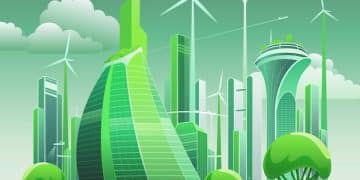US Green Tech ROI: Top Emerging Technologies for the Next 3 Years

US Market Analysis: Which Emerging Green Technologies Will See the Highest ROI in the Next 3 Years? focuses on identifying the most promising areas for investment in sustainable technologies within the United States, considering factors like market demand, technological advancements, and regulatory support.
The US Market Analysis: Which Emerging Green Technologies Will See the Highest ROI in the Next 3 Years? is a crucial question for investors and businesses alike. The green technology sector is rapidly evolving, and understanding which technologies are poised for significant growth and profitability is essential for making informed decisions.
Investing in a Greener Future: US Market Opportunities
The US market is ripe with opportunities for green technologies. As environmental awareness grows and regulatory pressures increase, investing in sustainable solutions is not only ethically sound but also economically advantageous. This section explores the overall landscape of green tech investment in the US.
Market Drivers for Green Technology
Several factors are driving the growth of the green technology market in the US, creating a fertile ground for innovation and investment.
- Government incentives and regulations promoting renewable energy and energy efficiency.
- Increasing consumer demand for sustainable products and services.
- Corporate sustainability initiatives and commitments to reduce carbon footprints.
- Technological advancements making green solutions more cost-effective and efficient.
Challenges and Opportunities
While the market presents significant opportunities, it also faces challenges that investors and businesses need to navigate.
- High initial investment costs associated with some green technologies.
- Uncertainty in regulatory policies and government support.
- Competition from established industries and technologies.
- Need for skilled workforce to develop and deploy green solutions.
Government policies and technological evolution are critical factors to be considered for understanding the future of green technology in the US.
Renewable Energy: Solar, Wind, and Beyond
Renewable energy remains a cornerstone of the green technology revolution. Solar and wind power have seen tremendous growth, but emerging technologies are also gaining traction.
Solar Energy Innovations
Solar energy technology continues to advance, offering new avenues for ROI.
- Perovskite solar cells: promising higher efficiency and lower manufacturing costs compared to traditional silicon cells.
- Floating solar farms: utilizing bodies of water for solar power generation, reducing land use conflicts.
- Building-integrated photovoltaics (BIPV): incorporating solar panels into building materials, enhancing energy efficiency.

Wind Energy Advancements
Wind energy is also evolving, with new technologies improving efficiency and reducing environmental impact.
- Offshore wind farms: harnessing stronger and more consistent winds in coastal areas.
- Vertical axis wind turbines (VAWTs): offering advantages in urban environments and complex terrains.
- Airborne wind energy: capturing high-altitude winds using tethered kites or drones for power generation.
Investing in renewable energy requires staying abreast of these evolving technologies and their potential impact. The future of solar and wind technologies will depend on how many companies are investing in them.
Energy Storage: The Key to Grid Stability
Energy storage is essential for integrating intermittent renewable energy sources into the grid. Advanced battery technologies and other storage solutions are crucial for ensuring a reliable energy supply.
Lithium-Ion Batteries
Lithium-ion batteries have become the dominant energy storage technology, but ongoing research aims to improve their performance and safety.
- Solid-state batteries: offering higher energy density and enhanced safety compared to traditional lithium-ion batteries.
- Lithium-sulfur batteries: promising even higher energy density and lower material costs.
Alternative Energy Storage Technologies
Beyond lithium-ion, several alternative energy storage technologies are emerging.
- Flow batteries: providing long-duration storage and scalability for grid-scale applications.
- Compressed air energy storage (CAES): storing energy by compressing air into underground caverns.
- Thermal energy storage: utilizing heat or cold storage for various applications, including heating and cooling.
Energy storage is not just about batteries; it’s about creating flexible and reliable energy systems. Different tech are available in the market and it can be tough choosing what to invest on.
Smart Grids and Energy Management
Smart grids and energy management systems are transforming how energy is generated, distributed, and consumed. Digital technologies are optimizing energy use and improving grid resilience.
Smart Grid Technologies
Smart grid technologies leverage data and automation to enhance grid performance.
- Advanced metering infrastructure (AMI): providing real-time data on energy consumption for improved billing and demand response.
- Grid-scale sensors and monitoring systems: enabling proactive detection and mitigation of grid disturbances.
- Cybersecurity solutions: protecting smart grid infrastructure from cyber threats.

Energy Management Systems
Energy management systems help businesses and consumers optimize their energy use and reduce costs.
- Building energy management systems (BEMS): automating energy consumption based on occupancy, weather, and other factors.
- Home energy management systems (HEMS): providing homeowners with insights into their energy use and control over their appliances.
Smart technologies are not just about efficiency; they’re about creating a more resilient and sustainable energy future. Integrating technologies becomes a priority.
Sustainable Transportation: EVs and Beyond
Sustainable transportation is a critical component of a green economy. Electric vehicles (EVs) are gaining popularity, but other innovative solutions are also emerging.
Electric Vehicle Technologies
Electric vehicle technology is rapidly advancing, with improvements in battery range, charging infrastructure, and vehicle performance.
- Fast charging infrastructure: reducing charging times and increasing EV convenience.
- Wireless charging: enabling contactless charging of EVs.
- Battery swapping technology: allowing drivers to quickly exchange depleted batteries for fully charged ones.
Alternative Transportation Solutions
Beyond EVs, other sustainable transportation solutions are gaining traction.
- Hydrogen fuel cell vehicles: offering long driving ranges and fast refueling times.
- Alternative fuels: such as biofuels and synthetic fuels, reducing reliance on fossil fuels.
- Micro-mobility solutions: including electric scooters and bikes, providing sustainable urban transportation options.
The future of transportation is electric, but also diverse, with a range of sustainable solutions catering to different needs.
Green Buildings and Construction
Green buildings and construction practices are transforming the built environment, reducing energy consumption and promoting sustainable resource management.
Sustainable Building Materials
Using sustainable building materials is essential for reducing the environmental impact of construction.
- Recycled and reclaimed materials: reducing waste and conserving resources.
- Bio-based materials: such as bamboo, timber, and hemp, offering renewable and sustainable alternatives.
Energy-Efficient Building Designs
Energy-efficient building designs minimize energy consumption and improve indoor environmental quality.
- Passive solar design: utilizing natural sunlight and ventilation to reduce heating and cooling needs.
- Smart building technologies: automating building systems for optimal energy performance.
Green buildings are not just about sustainability; they’re about creating healthier and more comfortable spaces for people to live and work.
| Key Point | Brief Description |
|---|---|
| ☀️ Solar Innovations | Perovskite cells & floating farms offer higher efficiency. |
| 🔋 Energy Storage | Solid-state batteries and flow batteries enhance grid stability. |
| ⚡ Smart Grids | AMI and smart sensors optimize energy distribution. |
| 🚗 Sustainable Transport | Fast charging and hydrogen fuel cells promote green transit. |
Frequently Asked Questions
▼
Emerging green technologies with high ROI potential include perovskite solar cells, solid-state batteries, smart grid technologies, and fast-charging infrastructure for electric vehicles, all driven by increasing demand and government incentives.
▼
Government incentives, such as tax credits and subsidies, significantly reduce the upfront costs for green technology projects, making them more financially attractive and accelerating their adoption across various sectors.
▼
Energy storage is crucial for stabilizing the grid by storing excess renewable energy and releasing it during peak demand, ensuring a consistent and reliable power supply, especially with intermittent sources like solar and wind.
▼
Businesses can benefit from reduced energy costs, improved employee productivity due to better indoor air quality, enhanced brand reputation as environmentally responsible, and potential eligibility for green building certifications and incentives.
▼
Key challenges include the high initial cost of electric vehicles, the limited availability of charging infrastructure, range anxiety among consumers, and the need for further advancements in battery technology and alternative fuel sources to improve efficiency.
Conclusion
The US market presents abundant opportunities for investing in emerging green technologies. By focusing on renewable energy, energy storage, smart grids, sustainable transport, and green buildings, investors can drive both financial returns and positive environmental impact, creating a greener and more sustainable future.





